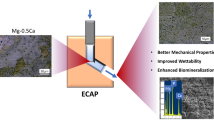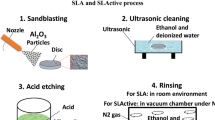Abstract
Biodegradable magnesium–calcium (MgCa) implants have the ability to gradually dissolve and be absorbed in human body after implantation. Since the implant surface is in direct interaction with body fluids, surface integrity of MgCa implants are key factors influencing degradation rate of the biodegradable implants. Machining is often very necessary to make geometric features of implants. The effects of process parameters in dry high-speed face milling of MgCa0.8 (wt%) alloy on surface integrity characteristics, i.e. surface topography, surface roughness, microstructure, microhardness, and residual stresses, are investigated in this study. Polycrystalline diamond inserts are used to avoid material adhesion in milling MgCa alloy. High cutting speeds of up to 2,800 m/min and a broad range of feed and depth-of-cut values are selected to cover the regimes of finish and rough cutting. Average roughness value of 0.4 μm and shallow strain hardened depths are achieved. Little change of grain size can be observed in the near surface even for very slow feed value of 0.05 mm/rev. The surface residual stresses are measured to be highly compressive.











Similar content being viewed by others
References
Gefen A (2002) Computational simulations of stress shielding and bone resorption around existing and computer-designed orthopaedic screws. Med Biol Eng Comput 40:311–322
Nagels J, Stokdijk M, Rozing P (2003) Stress shielding and bone resorption in shoulder arthroplasty. J Should Elb Surg 12:35–39
Isaksson H, Lerner A (2003) Mathematical modeling of stress shielding with bioresorbable materials for internal fracture fixation. In: Proceedings of 2003 summer bioengineering conference, 25–29 June, Sonesta Beach Resort in Key Biscayne, Florida, pp 1041–1042
Au A, Raso V, Liggins A, Amirfazli A (2007) Contribution of loading conditions and material properties to stress shielding near the tibial component of total knee replacements. J Biomech 40:1410–1416
Completo A, Fonseca F, Simoes A (2008) Strain shielding in proximal tibia of stemmed knee prosthesis: experimental study. J Biomech 41:560–566
Seiler H (1987) Handbook on toxicity of inorganic compounds, 1st edn. CRC Press, New York
Song G (2007) Control of biodegradation of biocompatible magnesium alloys. Corros Sci 49:1696–1701
Song G, Song S (2007) A possible biodegradable magnesium implant material. Adv Eng Mater 9:298–302
Videm M, Hansen R, Tomac N, Tonnesen K (1994) Metallurgical considerations for machining magnesium alloys. SAE Trans 103:213–220
Byrne G, Dornfeld D, Denkena B (2003) Advancing cutting technology. Ann CIRP 52:483–507
Danilenko B (2009) Selecting the initial cutting parameters in machining magnesium alloys. Russ Eng Res 29:316–318
Hallum D (1995) Magnesium: lightweight, easy to machine. Am Mach 139:48–51
Denkena B, Becker J, Podolsky C, Kuhlmann A (2007) Safe machining of magnesium parts by cutting and burnishing operations. In: Proceedings of the 7th international conference magnesium alloys and their applications, pp 895–901
Tönshoff H, Winkler J (1997) The influence of tool coatings in machining of magnesium. Surf Coat Tech 94–95:610–616
Friemuth T, Winkler J (1999) Machining of magnesium workpieces. Adv Eng Mater 1:183–186
Denkena B, Lucas A (2007) Biocompatible magnesium alloys as absorbable implant materials-adjusted surface and subsurface properties by machining processes. Ann CIRP 56:113–116
Bach F, Denkena B, Weinert K, Alpers P, Bosse M, Hammer N (2007) Influence of cutting and non-cutting processes on the corrosion behavior and the mechanical properties of magnesium alloys. In: Proceedings of the 7th international conference magnesium alloys and their applications, pp 1076–1084
Tönshoff H, Friemuth T, Winkler J, Podolsky C (2000) Improving the characteristics of magnesium workpieces by burnishing operations. In: Kainer KU (ed) Magnesium alloys and their applications. Wiley-VCH, Weinheim, pp 406–411
Tönshoff H, Winkler J, Gey C (1999) Machining of light metals. Mat wiss u Werkstofftech 30:401–417
Li Z, Gu X, Lou S, Zheng Y (2008) The development of binary MgCa alloys for use as biodegradable materials within bone. Biomaterials 29:1329–1344
Denkena B, Witte F, Podolsky C, Lucas A (2005) Degradable implants made of magnesium alloys. In: Proceedings of the 5th euspen international conference, Montpellier, France
Hassel T, Bach F (2007) Production and properties of small tubes made from MgCa0.8 for application as stent in biomedical science. In: Proceedings of the 7th international conference magnesium alloys and their applications, pp 432–437
Hassel T, Bach F, Krause C (2007) Influence of alloy composition on the mechanical and electrochemical properties of binary MgCa alloys and its corrosion behavior in solutions at different chloride concentrations. In: Proceedings of the 7th international conference magnesium alloys and their applications, pp 789–795
von Der Hoh N, Bormann D, Lucas A, Denkena B, Hackenbroich C, Meyer-Lindenberg A (2009) Influence of different surface machining treatments of magnesium-based resorbable implants on the degradation behavior in rabbits. Adv Eng Mater 11:B47–B54
Guo Y, Brooks V (2009) Characterization of mechanical property and microstructure of biomedical magnesium alloy. In: Proceedings of the ASM materials and processes for medical devices conference and Expo, Minneapolis
Massalski T (1990) Binary alloy phase diagrams, vol 1, 2nd edn. ASM International, Ohio, pp 927–928
Acknowledgments
This research is based upon the work supported by the National Science Foundation under Grant No. CMMI-1000706 and the Graduate Council Fellowship at University of Alabama.
Author information
Authors and Affiliations
Corresponding author
Rights and permissions
About this article
Cite this article
Salahshoor, M., Guo, Y.B. Surface integrity of biodegradable orthopedic magnesium–calcium alloy by high-speed dry face milling. Prod. Eng. Res. Devel. 5, 641–650 (2011). https://doi.org/10.1007/s11740-011-0341-y
Received:
Accepted:
Published:
Issue Date:
DOI: https://doi.org/10.1007/s11740-011-0341-y




